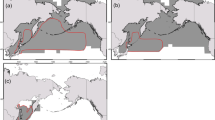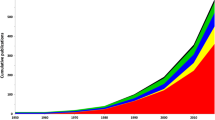Abstract
The reproductive ecology of two endangered subspecies of the bitterling Rhodeus atremius was investigated in two rivers in Okayama and Fukuoka Prefectures, Japan. Several other bitterling species, R. ocellatus, Tanakia limbata, T. lanceolata, Acheilognathus tabira and A. rhombeus, are also found in these rivers. Spawning of both R. atremius subspecies was recorded between late March and August 2007, peaking between April and July. Females of R. atremius began to mature at small body size (minimum 25 mm). They had small clutch sizes (maximum 16 eggs) and developed a short ovipositor (mean 13.6 mm), which was used to deposit a bulb-shaped egg of comparatively large size (3.2 mm3, major and minor axes 2.8 and 1.5 mm). Clutch size, ovipositor length and egg size appear to be a function of female body size. Both the body size and ovipositor length of R. atremius with ripe ova and the size and shape of the eggs varied seasonally. Rhodeus a. suigensis achieved maturity at a smaller body size, had a longer ovipositor and produced smaller eggs, with the minor axis being wider relative to the major axis than those of R. a. atremius. Rhodeus atremius may be adapted for depositing small numbers of eggs in a much shallower position inside the gills of smaller host mussels than other bitterling species.





Similar content being viewed by others
References
Aldridge DC (1997) Reproductive ecology of bitterling (Rhodeus sericeus Pallas) and unionid mussels. Unpubl PhD Thesis, Cambridge University, Cambridge
Aldridge DC (1999) Development of European bitterling in the gills of freshwater mussels. J Fish Biol 54:138–151
Coleman RM (1991) Measuring parental investment in nonspherical eggs. Copeia 1991:1092–1098
Fukuhara S, Maekawa W, Nagata Y (1998) Comparison of utilization of freshwater mussels for deposition of the bitterlings in three creeks of northwest Kyushu. Mem Osaka Kyouiku Univ Ser III 47:27–37
Kawamura K (2003) Rhodeus atremius suigensis. In: Ministry of Environment (ed) Threatened wildlife of Japan, Red data book, 2nd edn, vol 4. Pisces, brackish and freshwater fishes. Japan Wildlife Research Center, Tokyo, pp 46–47
Kimura S (2003) Rhodeus atremius atremius. In: Ministry of Environment (ed) Threatened wildlife of Japan, Red data book, 2nd edn, vol 4. Pisces, brackish and freshwater fishes. Japan Wildlife Research Center, Tokyo, pp 152–153
Kitamura J (2005) Factors affecting seasonal mortality of rosy bitterling (Rhodeus ocellatus kurumeus) embryos on the gills of their host mussel. Pop Ecol 47:41–51
Kitamura J (2006a) Seasonal change in the spatial utilization of host mussels in relation to ovipositor length by female rosy bitterling, Rhodeus ocellatus kurumeus. J Fish Biol 68:594–607
Kitamura J (2006b) Adaptive spatial utilization of host mussels by female rosy bitterling, Rhodeus ocellatus kurumeus. J Fish Biol 69:263–271
Kitamura J (2006c) Reproductive ecology of striped bitterling Acheilognathus cyanostigma (Cyprinidae: Acheilognathinae). Ichthyol Res 53:216–222
Kitamura J (2007) Reproductive ecology and host utilization of four sympatric bitterling (Acheilognathinae, Cyprinidae) in a lowland reach of the Harai River in Mie, Japan. Environ Biol Fish 78:37–55
Kondo T, Yamashita J, Kano M (1984) Breeding ecology of five species of bitterling (Pisces: Cyprinidae) in a small creek. Physiol Ecol Jpn 21:53–62
Mills SC, Reynolds JD (2002a) Host species preferences by bitterling, Rhodeus sericeus, spawning in freshwater mussels and consequences for offspring survival. Anim Behav 63:1029–1036
Mills SC, Reynolds JD (2002b) Mussel ventilation rates as a proximate cue for host selection by bitterling Rhodeus sericeus. Oecologia 131:473–478
Mills SC, Taylor MI, Reynolds JD (2005) Benefits and costs to mussels from ejecting bitterling embryos: a test of the evolutionary equilibrium hypothesis. Anim Behav 70:31–37
Nagata Y, Nakata Y (1988) Distribution of six species of bitterlings in a creek in Fukuoka Prefecture. Jpn J Ichthyol 35:320–331
Nakamura M (1969) Cyprinid fishes of Japan. Studies on the life history of cyprinid fishes of Japan. Research Institute for Natural Resources, Tokyo
Reichard M, Liu H, Smith C (2007) Oviposition host use, host preferences and host responses in the relationship between bitterling fishes and freshwater mussels: an insight from interspecific comparisons. Evol Ecol Res 9:1–21
Smith C, Reynolds JD, Sutherland WD, Jurajda P (2000) Adaptive host choice and avoidance of superparasitism in the spawning decisions of bitterling (Rhodeus sericeus). Behav Ecol Sociobiol 48:29–35
Smith C, Rippon K, Douglas A, Jurajda P (2001) A proximate cue for oviposition site choice in the bitterling (Rhodeus sericeus). Freshwat Biol 46:903–911
Smith C, Reichard M, Jurajda P, Przybylski M (2004) The reproductive ecology of the European bitterling (Rhodeus sericeus). J Zool Lond 262:107–124
Suzuki N, Hibiya T (1984a) Minute tubercles on the skin surface of larvae of Rhodeus (Cyprinidae). Jpn J Ichthyol 31:198–202
Suzuki N, Hibiya T (1984b) Development of eggs and larvae of two bitterlings, Rhodeus atremius and Rhodeus suigensis (Cyprinidae). Jpn J Ichthyol 31:287–296
Suzuki N, Hibiya T (1985) Minute tubercles on the skin surface of larvae of Acheilognathus and Pseudoperilampus (Cyprinidae). Jpn J Ichthyol 32:335–344
Acknowledgments
We are grateful to Mr. I. Kobayashi (Okayama Freshwater Fish Society), Y. Soma (Ushimado Marine Laboratory, Okayama University) and K. Tominaga (Laboratory of Animal Ecology, Kyoto University) for their help with the field survey, and Dr. Y. Nagata (Biology Laboratory, Osaka Kyoiku University) for providing unpublished data of host mussel utilization of R. a. atremius, and Mr. K. Kimura and Okayama and Chikugo Office of River, Chugoku and Kyushu Regional Development Bureau, Ministry of Land, Infrastructure and Transport for providing unpublished data of habitat in winter and water temperature. We also thank Dr. R. Spence and C. Smith (Department of Biology, University of Leicester) for their useful suggestions and assistance with English in the manuscript.
Author information
Authors and Affiliations
Corresponding author
About this article
Cite this article
Kitamura, Ji., Abe, T. & Nakajima, J. The reproductive ecology of two subspecies of the bitterling Rhodeus atremius (Cyprinidae, Acheilognathinae). Ichthyol Res 56, 156–161 (2009). https://doi.org/10.1007/s10228-008-0079-5
Received:
Revised:
Accepted:
Published:
Issue Date:
DOI: https://doi.org/10.1007/s10228-008-0079-5




